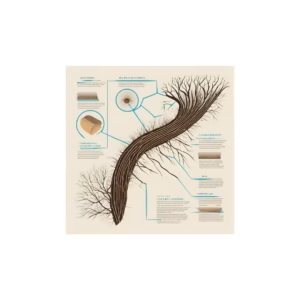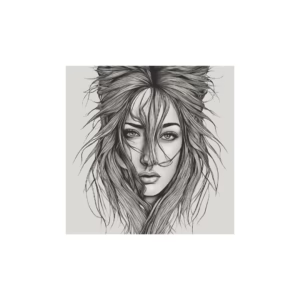Trichoptilosis is also known as Split ends. The protective outer layer of the hair cuticle is sometimes damaged, resulted in the hair fibers split into two or more strands. Due to this condition your hair looks dry and frizzy. Split ends are annoying for both boys and girls.
Causes of Split ends
Now let’s examine what causes this condition.
Brushing and Combing: Some people brush and combing hair aggressively. This act can cause friction and damage to the hair cuticle.
Tight Hairstyles: Tight hairstyling is another cause of split ends. Pulling the hair tightly into ponytails can press your hair and cause stress and breakage.
Heat Styling: Styling tools like curling irons and blow dryers can squeeze moisture from the hair. The hair becomes dry and lead to split ends.
Chemical Damage:
Due to Chemical treatments like coloring, relaxing and perming the hair structure weaken and led to split ends.
Environmental Factors:
Living in harsh environments such as wind and extreme temperatures can destroy the hair cuticle.
Lack of Moisture:
Insufficient moisture can make your hair dry and make the hair more vulnerable to splitting.
Nutritional Deficiencies:
A lack of essential minerals and vitamins can affect the health of the hair.
Over washing:
Frequent Washing the hair or using substandard shampoos can strip the natural oils from the hair.
Genetics causes of split ends:
Genetic factors are also responsible for Trichoptilosis.
Types of split ends
Basic Split:
The common type of split ends, where the hair splits into two at the end.
Feather Split Ends:
In feather splits, the hair strands may look like a feather.
Tree Split Ends:
The split extends into multiple branches, resembling a tree.
Hair Bulb:
This type of Trichoptilosis looks like a bulb at the end of the hair shaft, and it can make the hair appear thicker at the tips.
How to manage split ends at home
The following measure can be taken to control Trichoptilosis
DIY hair masks for split ends
Regular hair masks can prevent new split ends. you can try the following DIY hair masks:
Avocado and Olive Oil Mask for split ends:
Ingredients:
1 ripe avocado
Olive oil 2 tablespoons
Instructions:
Mix olive oil with mashed the avocado to form a smooth paste.
Apply the mixture to damp hair.
rinse with lukewarm water after 30 minutes
Honey and Coconut Oil Mask:
Ingredients needed:
2 tablespoons coconut oil
1 tablespoon honey
Instructions:
Combine honey and coconut oil. Warm the mixture slightly if needed.
Apply the mixture to your hairs.
Leave it on for 20-30 minutes and then shampoo and condition.
Yogurt and Banana Mask:
Required:
1 ripe banana
2 tablespoons plain yogurt
Instructions:
Blend the banana and yogurt to become smooth.
Apply to your hair till the ends.
Rinse thoroughly after 30 minutes .
Egg and Olive Oil Mask:
Ingredients:
1 egg
2 tablespoons olive oil
Instructions:
Mix the already beat egg with olive oil.
Apply to your hair.
Rinse with cool water after 20-30 minutes.
Aloe Vera and Jojoba Oil Mask:
Ingredients:
1 tablespoon jojoba oil
3 tablespoons aloe vera gel
Instructions:
Mix jojoba oil with aloe Vera gel.
Apply to your hair, paying attention to the split ends.
Wash it out after 30 minutes.
Remember to apply these masks to damp hair. It is better to cover your hair with warm towel so that the ingredients are fully absorbed.
Professional treatment for split ends
Olaplex Treatment:
Olaplex is a professional hair treatment plan that helps repair and strengthen damaged hair. It works by reconnecting disulphide bonds in the hair shaft to reduce breakage and improve hair health.
Keratin Treatment:
Keratin treatments involve the application of a keratin-based formula to the hair, which helps smooth the cuticle, reduce frizz, and improve the overall texture of the hair. While it doesn’t specifically target split ends, it can improve the overall appearance of damaged hair.
Protein Treatments:
Protein treatments are designed to strengthen the hair by providing it with additional protein, which is a building block of hair. Such treatments can help reduce breakage of hair
Micro-Trimming:
Some salons offer micro-trimming services where only the damaged or split portions of the hair are trimmed, allowing you to retain more length while still addressing split ends.
Professional treatments
Certain professional treatments are specifically formulated to mend the condition temporarily. These treatments often use polymers or other ingredients to bind split ends together, making the hair appear smoother.
Moisture and Hydration Treatments for split ends:
Professional moisturizing and hydration treatments can help nourish dry and damaged hair, reducing the likelihood of split ends. These treatments often involve the use of deep conditioning masks or steam treatments.
Scalp Treatments:
Some split ends may be caused by an unhealthy scalp. Professional scalp treatments, such as exfoliating or moisturizing treatments, can contribute to a healthier scalp environment, promoting healthier hair growth.
Hot Oil Treatments for split ends:
Hot oil treatments offered in salons can provide intense hydration to the hair, reducing dryness and improving the overall condition of the hair.
Best Vitamins for Hair Health and Split ends Prevention
Several vitamins are essential in promoting overall hair health and may contribute to the prevention of Trichoptilosis . Here are some key vitamins that can support hair health:
Vitamin A:
Role: Vitamin A helps in the production of sebum that moisturizes the scalp.
Sources: Vitamin A is in spinach, Sweet potatoes, kale, carrots and butternut squash.
Vitamin E:
Role: Vitamin E acts as an antioxidant and increases blood circulation to the scalp.
Sources: Spinach, nuts, almonds, seeds, broccoli and sunflower oil.
Vitamin C:
Role: Supports collagen production, which is essential for hair strength and structure.
Sources: Vitamin C is found in tomatoes, strawberries, bell peppers, citrus fruits and kiwi.
Biotin (Vitamin B7):
Role: Supports the health of hair, skin, and nails; helps prevent hair breakage.
Sources: Eggs, nuts, seeds, sweet potatoes, salmon.
Niacin (Vitamin B3):
Role: Improve blood circulation to the scalp.
Sources: Meat, fish, peanuts, mushrooms, whole grains.
Pantothenic Acid (Vitamin B5):
Role: Supports hair follicle health. It can also help prevent hair thinning.
Sources: Avocado, sunflower seeds, mushrooms, chicken, broccoli.
Vitamin D:
Role: Plays a role in the hair growth cycle; deficiency may contribute to hair loss.
Sources: Fatty fish, sun exposure and fortified dairy products.
Vitamin K:
Role: Supports healthy hair growth by assisting in the process of blood clotting.
Sources: Brussels sprouts and Leafy greens (kale, spinach, broccoli).
Vitamin B6:
Role: Increases hemoglobin, responsible for carrying oxygen to hair follicles.
Sources: Beef liver, chickpeas, , tuna, turkey.
Folic Acid (Vitamin B9):
Role: Supports cell division and may help prevent hair loss.
Sources: beans, leafy greens, citrus fruits, fortified cereals.
Some minerals like zinc, iron and copper are also beneficial for hair health.
Also read: 10 Dietitian-approved foods for speedy hair growth
How to prevent split ends:
To prevent split ends, the following tips will be helpful.
Pre-Treatment Oil Massage:
Apply coconut oil, argon oil or olive oil to your hair and scalp.
Steam Treatment:
Wrap your hair in a warm, damp towel to create a steam treatment. This will allow the oil to penetrate better.
Clarifying Rinse:
Rinse your hair with warm water to remove excess oil.
Reduce Heat Styling:
Stop heat styling tools during and after the detox to prevent further damage.
Protect Your Hair:
Use protective styles to minimize exposure to environmental factors that can damage your hair, such as sun, wind, and pollution.
Regular Trims:
Regular trims are necessary to get rid of existing split ends.
Limit Heat Exposure:
Stop heat styling for a while. Embrace natural hairstyles on non-styling days. This will help you to reduce heat exposure.
Air Dry When Possible:
If possible, try to dry out your hair in air, especially during warmer. Set the blow dryer to the lowest heat setting and avoid concentrating on one section.
Reduce Straightening and Curling Time:
Section your hair and work in smaller portions.
Avoid Direct Heat on Wet Hair:
Don’t use styling tools on wet hair. Excessive heat on wet hair can cause damage.
Use of a Wide-Toothed Comb:
Use a wide-toothed comb before using heat styling tools. This reduces the stress on your hair during styling.
Apply Heat at the Right Distance:
Hold styling tools at a safe distance from your hair to avoid excessive heat exposure. This is especially important for curling irons and straighteners.
Protective Hairstyles:
Adopt protective hairstyles like buns or braids to minimize the need for daily heat styling.
Haircut or Trim:
A professional haircut or trim by a stylist is the most effective way to get rid of split ends. Regular trims every 6-8 weeks help maintain healthy hair and prevent splits.
The final words:
We have thoroughly highlighted the whole picture of split ends. Now it’s upon you to decide how to deal with it. Thanks for reading. For more such articles, stay with us at Azilife.com


